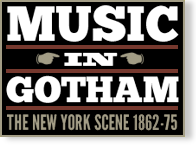United Choirs of Trinity Parish
Event Information
Venue(s):
Trinity Chapel [W. 25th St.]
Conductor(s):
A. H. Messiter
Charles Edward Horsley
J. H. Cornell
Event Type:
Choral
Record Information
Status:
Published
Last Updated:
28 February 2025
Performance Date(s) and Time(s)
20 Nov 1873, 8:00 PMProgram Details
Performers and/or Works Performed
Citations
“The united choirs of Trinity Parish met Thursday evening, at the services in Trinity Chapel West Twenty-fifth street. The meeting was the first of the united choirs since 1867, and the occasion of their coming together appeared to be regarded as something in the nature of a musical festival, devoted, of course, solely to sacred composition. At all events, the occasion was extremely interesting, and, as might be readily anticipated, the church was crowded. The choirs present were: Trinity Church under the direction of Mr. A. H. Messiter; St. Paul’s Chapel, under the direction of Mr. J. H. Cornell; St. John’s Chapel, under the direction of Mr. C. E. Horsley, and Trinity Chapel, directed by Mr. W. Gilbert. The service commenced with the processional hymn, ‘Pleasant are Thy Courts Above,’ which was followed by the 118th Psalm. [Lists prayers, readings.] The united choirs next sang the hymn, (the 125th of the Hymnal,) ‘The Strain Upraise of Joy and Praise.’ [Describes address by minster.] He referred to the former union of the choirs in 1867, and to the wish which he then expressed that they might meet every year. That desire had, however, been unfulfilled, and six years and eight months had passed away without any further union until the present. However, he had to renew the hope that this union of the parish choirs might be carried to yearly. There were many good purposes to be served by such assemblages. They promoted unity, and would be sure to serve the interests of church music. Music was the fair daughter of a better sphere, and as she had done much for us, so we should consider what we might do for her. There was a pure spiritual power in music, and it was the only one of the fine arts that could not be used directly by the vile. The other fine arts—painting, sculpture, poetry—they were not always pure. On the contrary, they might be made most potent instruments for evil in the hands of the vicious… But music could not be used in that way. [Goes on in this manner.] [The minister also noted that something] to be apprehended in church music was the glaring incongruity between the music performed and the circumstances under which it is given. If there were any occasion on which church music should be impressive and solemn, it was the burial of the dead. And yet he had witnessed an occasion, at the burial of a dear friend, when that music which should have been given in a solemn and sombre [sic] manner was sung by a single soprano voice with trills, roulades, and vocal gymnastics that he was pained to hear. And the matter which could not be too strongly condemned was the fact that the music at church services should have a plan and purpose, but some of them were mere concerts, with the prayers and offices brough tin by way of accompanist. He remembered, last Easter, having seen a programme of music for church service containing no less than seventeen pieces, no two of them by the same composer, and not the last unity between them. Much of these evils, he believed, would be removed by such unions as that which they then held, and, therefore, he renewed the wish expressed by him in 1867, on a similar occasion, that the union of choirs of Trinity Parish might, in the future, be carried out every year. At the conclusion of Rev. Dr. Dix’s address several anthems were performed, illustrative of the history of ecclesiastical music. The services terminated with the benediction and recessional hymn. The singing of the united choirs throughout the services was eminently satisfactory. They seemed to be in perfect accord and harmony, and the rendering of the fine hymn, ‘The Strain Upraise,’ was especially effective.”

